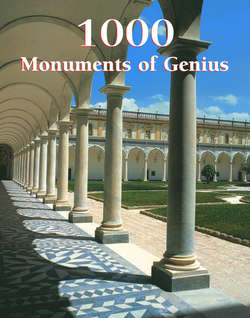1000 Monuments of Genius

Реклама. ООО «ЛитРес», ИНН: 7719571260.
Оглавление
Christopher E.M. Pearson. 1000 Monuments of Genius
Introduction
What is Architecture?
Structure and Materials
Architecture as Theory
Africa and the Middle East
Asia and Oceania
India and Southeast Asia
China
Japan and Korea
The 19th and 20th Centuries
Australia and Oceania
Europe (including Russia and Turkey)
The Americas
Biographies
Alvar Aalto
Robert Adam
Leon Battista Alberti
Tadao Ando
Luis Barragán
Peter Behrens
Gian Lorenzo Bernini
Mario Botta
Donato Bramante
Marcel Breuer
Filippo Brunelleschi
Michelangelo Buonarroti
Le Corbusier
Johann Bernhard Fischer von Erlach
Hassan Fathy
Norman Foster
Richard Buckminster Fuller
Antoni Gaudí
Frank Gehry
James Gibbs
Michael Graves
Eileen Gray
Walter Gropius
Zaha Hadid
Victor Horta
Thomas Jefferson
Philip Johnson
Inigo Jones
Filippo Juvarra
Louis Kahn
Rem Koolhaas
Louis Le Vau
Daniel Libeskind
Adolf Loos
Charles Rennie Mackintosh
Richard Meier
Erich Mendelsohn
Charles Moore
Julia Morgan
Richard Neutra
Oscar Niemeyer
Jean Nouvel
Andrea Palladio
Ieoh Ming Pei
Auguste Perret
Renzo Piano
Henry Hobson Richardson
Richard Rogers
Aldo Rossi
Eero Saarinen
Jacopo Sansovino
Karl Friedrich Schinkel
Sir John Soane
James Stirling
Louis Henry Sullivan
Kenzo Tange
Ludwig Mies van der Rohe
Robert Venturi
Otto Wagner
Sir Christopher Wren
Frank Lloyd Wright
Chronology
Glossary
Отрывок из книги
Among the major visual arts, architecture has always had something of a reputation for being difficult to appreciate. This is not solely because it would seem to require a large degree of professional skill both to design and to understand, at least in a technical sense. Unlike a painting or a sculpture, a building does not tell an easily decipherable narrative or attempt to ‘represent’ some aspect of reality in artistic terms. Rather, the nature of architecture is at least in part utilitarian, serving to shelter various human activities. At the same time, architecture dignifies our daily actions by giving them a distinctive public presence in the form of a building envelope or façade, one that in the case of many historical edifices may present us with a bafflingly complex articulation. In this sense, the busy external appearance of, say, Chartres Cathedral or the Pompidou Centre may indeed prove intimidating to the visitor who encounters them for the first time. In many cases, the means of creation of a given building, including its structural techniques and even its materials, may not be immediately evident or easily comprehended by the casual viewer. Its stylistic, historical and iconographic points of reference may be obscure and unfamiliar. Should one know, or care, for example, that the colossal Ionic columns fronting the 19th-century British Museum are based on those of the Temple of Athena Polias at Priene from the 4th century BCE? What insight might such an observation give us into the nature of the later edifice? Moreover, the very function of a building may often be inaccessible from a purely visual inspection, especially if its original purpose has been forgotten or has changed over time: what was Stonehenge used for, and what does one do inside a basilica, a pagoda or a martyrium, for instance? On the other hand, unlike our encounter with a work of art in a museum, we generally experience architecture in a state of distraction: as the German philosopher Walter Benjamin once noted, we do not see and appreciate buildings so much as we simply use them or walk past them or through them. Buildings become invisible to us. This points, however, to the major reason why the study of architecture should never be daunting to the beginner: it is the art we all use every day, and each of us has a lifetime of experience with it. In this sense, as we move from home to office to shopping mall to museum to hotel, we are all architectural experts, formed by a quotidian process of the visual assessment, navigation, tactile engagement and habitation of three-dimensional spaces that have been designed by professional builders or architects.
Perhaps a more basic – though equally unsatisfactory – aspect of the ‘elite’ definition of architecture lies in its inherent bias towards monumentality: what about those cultures that, for whatever reason, chose not to build durable or extravagant monuments? Would not this definition exclude the extraordinarily skilful but often small-scale or impermanent structures of many Native American, Oceanic or African tribal groups, the domestic buildings of the ancient Greeks, or any number of localised traditions making use of fragile materials or given to humble, everyday uses? This perhaps unrealistic discrimination lies behind architectural historian Nikolaus Pevsner’s famous comparison of a cathedral and a bicycle shed in his Outline of European Architecture (1943): the former was held to represent ‘architecture’ (perhaps even with a capital A) with distinct ‘aesthetic appeal’ while the latter was seen as mere ‘building’ of a strictly functional character. As this example suggests, the question is at the same time complicated by the professional divide between architecture and engineering (and indeed building and contracting). Can purely utilitarian structures, whatever their technical merits, be seen as architecture? The success of the modern movement in deliberately merging or blurring the parameters of both fields has perhaps rendered the question less pressing in the present day, but the status of ancient shelters, barns, warehouses and the like has yet to be dealt with.
.....
39. Al-Aqsa Mosque, Jerusalem, rebuilt 1033 (Israel)
40. Krak des chevaliers, Qalaat al Hosn, c. 1100–1200 (Syria)
.....